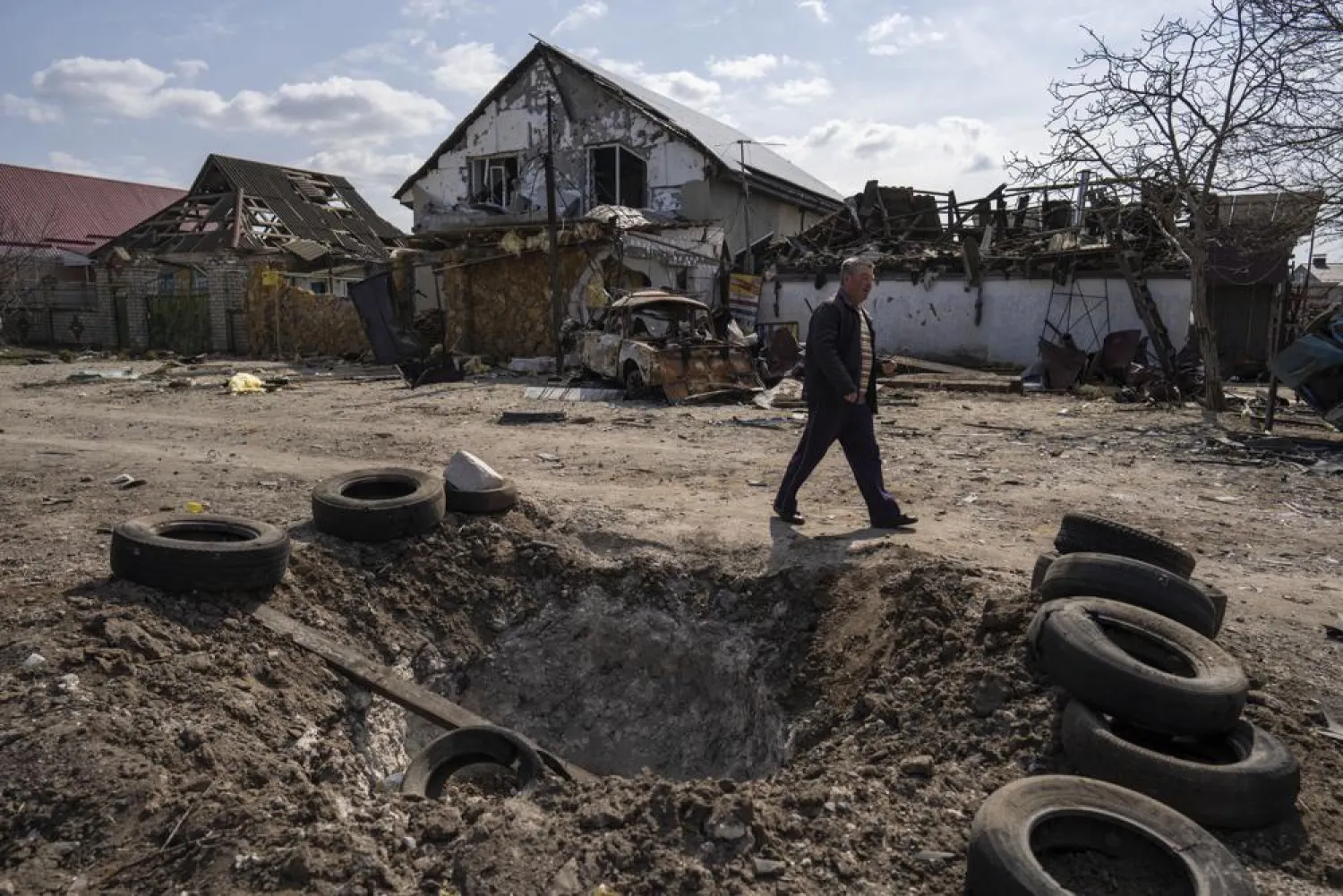Like many residents of Ukraine's besieged city of Chernihiv, linguistics scholar Ihar Kazmerchak spends his nights in a bomb shelter and starts his day lining up for the little potable water authorities have left to hand out.
Surrounded by Russian forces and under constant bombardment, the northern city known for its eclectic monasteries has no electricity, heating or running water. The lists at pharmacies of the medicines no longer available grow longer by the day.
“In basements at night, everyone is talking about one thing: Chernihiv becoming next Mariupol,” Kazmerchak, 38, said, referring to the southern port city 845 kilometers (525 miles) away that has suffered some of the worst horrors since Russia invaded Ukraine.
The fear is not misplaced. Russian bombs destroyed Chernihiv's main bridge over the Desna River on the road leading to Kyiv on Wednesday; on Friday, artillery shells rendered the remaining pedestrian bridge impassable, cutting off the last possible route for people to get out or for food and medical supplies to get in.
Just over a month into the invasion, Russia's attack has slowed into a grinding war of attrition as its military tries to pound cities like Chernihiv into submission. Bombings of hospitals and other non-military sites, such as the Mariupol theater where Ukrainian officials said a Russian airstrike is believed to have killed some 300 people last week, have given rise to war crime allegations.
Questions about the direction of Russia's offensive surfaced Friday when a high-ranking military official said the main objective of the first stage of the operation — reducing Ukraine’s fighting capacity — had “generally been accomplished.” Col.-Gen Sergei Rudskoi, deputy chief of the Russian general staff, said Russian forces could now focus on “the main goal, the liberation of Donbas.”
Donbas is the largely Russian-speaking eastern region where Russian-backed separatists have been fighting Ukrainian forces since 2014 and where many residents desire close ties to Moscow. Mariupol is located there, although outside of the two territories controlled by the separatists.
US officials said Russian troops appeared to have halted for now their ground offensive aimed at capturing the capital, Kyiv, and were concentrating more on gaining control of the Donbas region in the country’s southeast.
However, British defense officials reported Saturday that the Russian military continues to besiege a number of other major Ukrainian cities, including Chernihiv, which is located 146 kilometers (91 miles) from Kyiv.
“It is likely Russia will continue to use its heavy firepower on urban areas as it looks to limit its own already considerable losses, at the cost of further civilian casualties,” the UK Ministry of Defense said in its latest intelligence briefing on the war.
Ukrainian President Volodymyr Zelenskyy, appearing by video-link at Qatar's Doha Forum, on Saturday compared the destruction of Mariupol to the Syrian and Russian destruction wrought on the city of Aleppo.
“They are destroying our ports,” Zelenskyy said. “The absence of exports from Ukraine will deal a blow to countries worldwide.”
He called on countries to increase their exports of energy to give European nations an alternative to Russian oil and gas.
“The future of Europe rests with your efforts,” he said.
In Kyiv, ashes of the dead are piling up at the main crematorium because so many relatives have left, leaving urns unclaimed. For civilians who decided to stay or have been unable to leave under constant shelling, the misery is growing more severe.
In Yasnohorodka, a village some 50 kilometers (30 miles) west of Kyiv that Russian troops who occupied earlier in the week, appeared to have been pushed out as part of a counteroffensive by Ukrainian forces. Houses on the main crossroads lay in ruins. The tower of the village church was damaged.
“You can see for yourself what happened here. People were killed here. Our soldiers were killed here,” Yasnohorodka resident Valeriy Puzakov said.
In Chernihiv, hospitals are no longer operating, and residents cook over open fires in the street because the power is out.
Chernihiv Mayor Vladyslav Atroshenko has said that more than half of the city’s 280,000 residents fled amid the unrelenting attack.
Russian forces, he told Ukrainian television, “are deliberately destroying civilian infrastructure – schools, kindergartens, churches, residential buildings and even the local football stadium.”
It has been impossible to count the dead, but Atroshenko estimated the figure was “in the hundreds.”
Located only about 70 kilometers (45 miles) from the border with Belarus on the road to Kyiv, Chernihiv was attacked in the early days of the war and encircled by Russian troops this month, but its defenders so far have prevented a takeover.
“Chernihiv has become a symbol of the Russian army’s failed blitzkrieg, in which the plan was to take the city over in one day and advance towards Kyiv,” Mykola Sunhurovskyi, a military analyst at the Kyiv-based Razumkov Center think tank, said.
Kazmerchak started spending his night in a bomb shelter after a Russian bomb hit the Stalin-era movie theater next to the 12-story residential building where he lived. A Russian missile also destroyed the hotel not far from his house.
“The walls were shaking so much that I thought my house would collapse any minute and I would be left under the rubble,” Kazmerchak said.
Dwindling supplies led to long lines out of the few grocery stores that still had food. Shelling killed 10 civilians on March 16 as they waited outside to buy bread. Residents hunkered down and stayed home, but as the siege endures, some have given up on trying to stay safe, Kazmerchak said.
“Ravaged houses, fires, corpses in the street, huge aircraft bombs that didn’t explode in courtyards are not surprising anyone anymore,” he said. “People are simply tired of being scared and don’t even always go down to the basements.”









